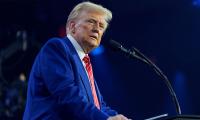LAHORE: As elected Afghan President Ashraf Ghani, seeking a second term, and his arch rival, Abdullah Abdullah, have both declared themselves as country’s new heads of state - claiming they had won the Presidential election, a political turmoil has certainly engulfed the war-torn nation.
In case both Ashraf Ghani and Abdullah fail to sort out their differences amicably, the situation in Afghanistan would be similar to what the most urbanized Latin American nation of Venezuela is currently facing since start of 2019.
Research shows that as is the case in Afghanistan, the crisis had brewed up after the results of the Presidential ballot, whereby the losing candidate refused to accept the outcome, dubbed the voting exercise rigged and vowed to form a parallel government.
Key American media houses like the Associated Press, Washington Post, the CNN and the New York Times etc have been reporting on the crisis concerning as to who was the legitimate president of Venezuela.
This crisis had been underway since January 2019, with the nation and the world divided in support for Nicolás Maduro or Juan Guaidó.
Maduro was narrowly elected in 2013 after the death of populist President Hugo Chávez and reelected in May 2018 in an allegedly rigged election.
Maduro has allegedly used the Venezuelan courts, security forces, and electoral council to quash dissent. On January 27, 2020, the Maduro government had reportedly held 390 political prisoners.
At the same time, Maduro has rewarded allies, including the military, with income from illegal gold mining, drug trafficking, and other illicit activities.
While Russia, China, Iran, Turkey, Syria, and Cuba supported Maduro, the United States, Canada, and most of Western Europe backed Juan Guaidó as interim president.
Although the United States and 56 other countries recognize Guaidó as interim president, he has been unable to wrest Maduro from power.
According to International Monetary Fund estimates, Venezuela’s economy contracted by 35% in 2019 and inflation reached some 200,000%.
In April 2019, U.N. officials estimated that some 90% of Venezuelans were living in poverty and a quarter of the population needed humanitarian assistance.
Health indicators, particularly infant and maternal mortality rates, had worsened. Previously eradicated diseases such as diphtheria and measles had returned and spread.
In December 2019, UN agencies estimated that 4.8 million Venezuelans had left the country, most of whom were in Latin America and the Caribbean. Migrant flows could increase, as electrical blackouts and US sanctions on oil production had worsened social conditions.
An American media outlet had reported: “On January 5, 2019, the National Assembly elected Guaidó, a 35-year-old industrial engineer from the Popular Will party, as its president. In mid-January, Guaidó announced he was willing to serve as interim president until new presidential elections were held. Buoyed by a massive turnout for anti-Maduro protests, Guaidó took the oath of office on January 23, 2019."
It added: “A year later, Guaidó remains the most popular politician in Venezuela, according to Gallup polling, and retains broad diplomatic support, but he lacks political power. In 2019, Guaidó’s supporters organised two high-profile but ultimately unsuccessful efforts to get security forces to abandon Maduro - in February, Guaidó supporters sought to bring emergency aid into the country across borders that Maduro had closed, and on April 30, Guaidó called for a civil-military uprising.”
By the way, during the 1942 “Quit India Movement”, parallel governments were formed in Midnapore in Bengal, Bhagalpur in Bihar, Ballia in Uttar Pradesh and Basudevpur in Odisha.
Sporadic small-scale violence took place around the undivided India and the British Empire had arrested tens of thousands of leaders, keeping them imprisoned until 1945.
In terms of immediate objectives, Quit India failed because of heavy-handed suppression, weak co-ordination and the lack of a clear-cut programme of action.
The only outside support for Gandhi’s movement came from the Americans, as US President Franklin Roosevelt had pressured British Prime Minister Winston Churchill to give in to some of the Indian demands. The Quit India campaign was effectively crushed.
The British refused to grant immediate independence, saying it could happen only after the war had ended.
In Tamluk and Contai subdivisions of Midnapore, the local populace were successful in establishing parallel governments, which continued to function, until Gandhi personally requested the leaders to disband in 1944.
A minor uprising took place in Ballia, now the easternmost district of Uttar Pradesh. People overthrew the district administration, broke open the jail, released the arrested Congress leaders and established their own independent rule. It took weeks before the British could reestablish their writ in the district.
According to author John Riddick’s book “The History of British India: A Chronology", from August 9, 1942 to September 21, 1942, the Quit India Movement had attacked 550 post offices, 250 railway stations, damaged many rail lines, destroyed 70 police stations, and burned or damaged 85 other government buildings.
There were about 2,500 instances of telegraph wires being cut. The greatest level of violence occurred in Bihar. The Government of India had a deployed 57 battalions of British troops to restore order.
PTI maintain leading position in NA elections, with narrow lead of one percentage point over PMLN
Nationalists say province's resources, land, and water were being sold under guise of development







